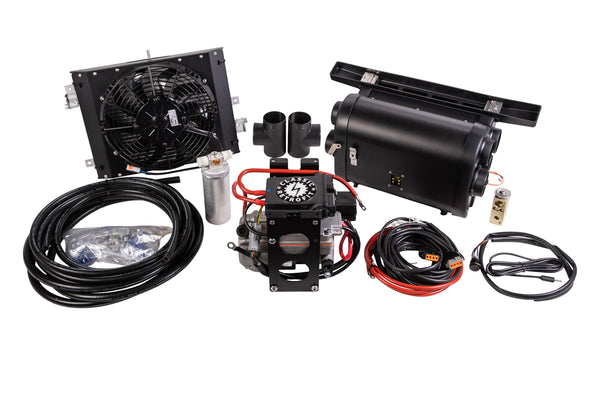Stuartc
True Classic
There are threads covering air conditioning retrofit but this is for a RHD vehicle ROW in my case for Australia on an “88 Bertone.
Rather than covering similar already covered info on LHD retrofits if anyone has any specific questions on a RHD conversion (remember ROW RHD models never had factory air conditioning offered) then I’m happy to let you know exactly what I did. Probably won’t be many as UK owners are unlikely to want to add A/C and Australian & NZ units are few in numbers .
.
All the complex jobs retrofitting Air Conditioning in my “88 Bertone are done jobs remaining are sourcing a parallel flow condenser, running charge hose underneath along the tunnel to the condenser and engine bay hoses to compressor.
Throughout the process my aim has been to update and improve the efficiency of the system which is actually pretty good but I’m in Australia and every bit, however small in efficiency improvements can make a big difference.
A parallel flow condenser which is far more efficient than the original Tube & Fin is one area which I’m yet to source. Due to the unique frontal area I’ll probably invest in a custom made condenser to maximise surface area, TBA.
Whilst at the front I’ve added another OE fan but now are 2 speeds.
Low speed is active on the activation of the A/C system.
High speed is triggered either by the trinary switch on the receiver/dryer reaching “High Pressure” threshold or
Radiator 2 temp sensor is triggered or
New sensor on thermostat reached threshold or
Dash mounted fan switch is activated. Dash switch is also fan status via LED illumination,
Green is normal backlighting
Blue is low speed fan state and
Red is high speed fan state.
I’ve also upgraded the lighting and heater control by using LED’s and a linear potentiometer for the heating controller which uses a solenoid controlled heater tap which will reside in the engine bay getting rid of any control cable.
As the vehicle is RHD the main harness to the rear of the car is the same side of the tunnel to LHD but the RHD has a drivers footrest which has a scollop for the main harness but not enough for the low side barrier hose back to the compressor. There also the accelerator rod. As such I’ve run the barrier hose inside the length of the tunnel making sure to avoid and secure so not to fowl the gear shift hardware. Pipe exits just before spare tyre well and as the LHD version up rear bulkhead an into engine compartment.

From here another modification is the heater which is used in the original system to help regulate the R12 by heating it before returning to the compressor which is always active.
I’ve removed the “Frost Valve” and now have a relay which is controlled via the trinary switch which will disengage the compressor in the event of a “High Pressure” state (safety switch) and a thermostat for the evaporator also connected to compressor control relay to disengage compressor when cold enough. Saying this these are all connected through the OE air conditioning relay modules and fuse/junction box. Only modifications to the A/C relay pack & junction/fuse box is direct electrical supply from battery via new fuse boxes. Therefore HVAC, cooling fans not relying on “Brown Wire” and ignition switch limitations.
The compressor control relay allowcompressor to cycle on demand and prevent “ice up”. The “TX” valve also helps regulate the evaporator temperature.
Internally RHD is obviously reverse to LHD so outboard vent hookups were 3D printed from original LHD units in “mirror image” and the centre stack air distributor had to have the vacuum control change to opposite side aswell as the recycle/fresh air vacuum control. All done and working perfectly.
My attention now is the engine side of things, compressor and I’m now considering with all the advances in EV whether it’s worth considering a 12v driven compressor? No, not going to electrify the X1/9 but running the compressor via electrical means is a possibility and I thought I’d ask anyone if they’d done any research into this possibility?
I’d rather do all the necessary work on the vehicle now before I strip and do the body and then find I have to drill holes or make modifications after the car has been fully restored and painted.
Any insight be greatly appreciated









Rather than covering similar already covered info on LHD retrofits if anyone has any specific questions on a RHD conversion (remember ROW RHD models never had factory air conditioning offered) then I’m happy to let you know exactly what I did. Probably won’t be many as UK owners are unlikely to want to add A/C and Australian & NZ units are few in numbers
All the complex jobs retrofitting Air Conditioning in my “88 Bertone are done jobs remaining are sourcing a parallel flow condenser, running charge hose underneath along the tunnel to the condenser and engine bay hoses to compressor.
Throughout the process my aim has been to update and improve the efficiency of the system which is actually pretty good but I’m in Australia and every bit, however small in efficiency improvements can make a big difference.
A parallel flow condenser which is far more efficient than the original Tube & Fin is one area which I’m yet to source. Due to the unique frontal area I’ll probably invest in a custom made condenser to maximise surface area, TBA.
Whilst at the front I’ve added another OE fan but now are 2 speeds.
Low speed is active on the activation of the A/C system.
High speed is triggered either by the trinary switch on the receiver/dryer reaching “High Pressure” threshold or
Radiator 2 temp sensor is triggered or
New sensor on thermostat reached threshold or
Dash mounted fan switch is activated. Dash switch is also fan status via LED illumination,
Green is normal backlighting
Blue is low speed fan state and
Red is high speed fan state.
I’ve also upgraded the lighting and heater control by using LED’s and a linear potentiometer for the heating controller which uses a solenoid controlled heater tap which will reside in the engine bay getting rid of any control cable.
As the vehicle is RHD the main harness to the rear of the car is the same side of the tunnel to LHD but the RHD has a drivers footrest which has a scollop for the main harness but not enough for the low side barrier hose back to the compressor. There also the accelerator rod. As such I’ve run the barrier hose inside the length of the tunnel making sure to avoid and secure so not to fowl the gear shift hardware. Pipe exits just before spare tyre well and as the LHD version up rear bulkhead an into engine compartment.
From here another modification is the heater which is used in the original system to help regulate the R12 by heating it before returning to the compressor which is always active.
I’ve removed the “Frost Valve” and now have a relay which is controlled via the trinary switch which will disengage the compressor in the event of a “High Pressure” state (safety switch) and a thermostat for the evaporator also connected to compressor control relay to disengage compressor when cold enough. Saying this these are all connected through the OE air conditioning relay modules and fuse/junction box. Only modifications to the A/C relay pack & junction/fuse box is direct electrical supply from battery via new fuse boxes. Therefore HVAC, cooling fans not relying on “Brown Wire” and ignition switch limitations.
The compressor control relay allowcompressor to cycle on demand and prevent “ice up”. The “TX” valve also helps regulate the evaporator temperature.
Internally RHD is obviously reverse to LHD so outboard vent hookups were 3D printed from original LHD units in “mirror image” and the centre stack air distributor had to have the vacuum control change to opposite side aswell as the recycle/fresh air vacuum control. All done and working perfectly.
My attention now is the engine side of things, compressor and I’m now considering with all the advances in EV whether it’s worth considering a 12v driven compressor? No, not going to electrify the X1/9 but running the compressor via electrical means is a possibility and I thought I’d ask anyone if they’d done any research into this possibility?
I’d rather do all the necessary work on the vehicle now before I strip and do the body and then find I have to drill holes or make modifications after the car has been fully restored and painted.
Any insight be greatly appreciated




